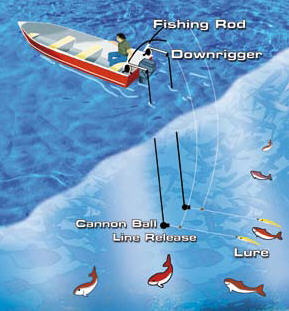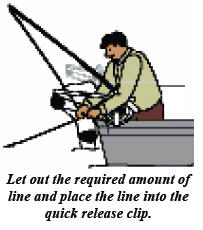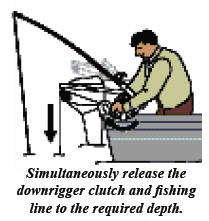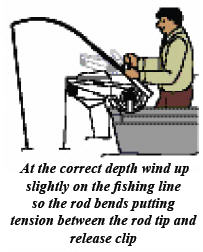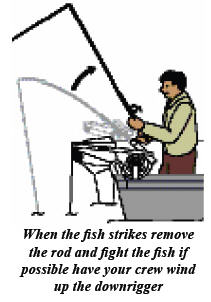|
|
Pulling
larger weights, and in the case of lead lines increased
diameter, through the water dictates the angler must use
a heavier class of rod and reel due to the increased drag.
With a lead line you will also require a dedicated rod /
reel combo, preferably a drum style reel as to avoid line
twist.
Taking this extra rig set up cost into consideration may
afford you a superior model when making a downrigger purchase
while still being able to use your current gear. There are
a variety of paravane’s available on today’s market
that can be rigged in a number of different ways, one of
the more popular is to rig the paravane directly to the
main line via a snap swivel. Then, connect the lure to the
paravane with a heavier mono / wire leader depending on
the species targeted. This to has its drawbacks, including
increased drag, the need to use a heavier line class and
the inability to gauge a specific depth as well as the need
to remove the rig from the water to change the point
of tow angle for variance in depth. Another factor to consider
is the boats speed, it is critical to the depth at which
the rig will operate
at, which in turn, will have an impact on the number of
different lures you can swim to gain maximum action.
Points
to Remember
When you first use a downrigger you will notice a strong
humming sound emanating from it, Downriggers do take a bit
to get used to and like all new things you try there will
be some trial and error but the secret is to be patient
as it will pay off in the long run.
I can remember one of the first times I used my Cannon Mini
Troll, I had set the line too deep into the reverse clip
with the end result, after
checking my rig, was one very dead Tailor being towed by
my Rapala CD9. Poor thing looked like it had been kissing
an air compressor. Still tasted fine though!!! As with any
lure or bait you are going to send out to the abyss, ensure
that it is swimming correctly prior to connecting it to
the downrigger bomb and lowering down into the water, as
it is impossible to know its actions without pulling the
bomb up. The length of line between the lure / bait and
downrigging bomb will vary depending on the species you
are targeting and the depth at which you are trolling at.
Remember that if you are trolling a bibbed lure it will
still dive to its normal depth below the point at which
it is being pulled. This depth
will need to be taken into consideration when setting the
depth you desire, this will also have a bearing as to the
distance from the bomb to the lure.
Speed and length of cable are defining factors to the final
depth the bomb will run at and quality sonar is a useful
tool when downrigging as
you can see the depth the bomb is operating at on the screen.
Due to drag when being pulled through the water a bow is
created in the
downrigging line causing a bomb to ride higher in the water,
this is commonly known as blow back.
What’s
right for me?
Once again this is dependant on what you are going to target
and the depth at which you need to reach that target. I
have owned a pair
of Cannon Mini Troll’s for over 10 years now and they
have accounted for a number of different species from Trout
to Spaniard’s. I attach
my berley bombs to them when fishing for Bream and Whiting
in rivers and quite often dead Squid in heavy tidal areas
when targeting Jewies. A few mates of mine are also having
great success targeting Barra in some of the deep dams in
South East QLD and Central QLD and another mate down south
who is cleaning up Trout around the Jindabyne area.
The Cannon brand of downrigger offer a large range to suit
all levels of budgets and set up requirements with different
models coming in both
manual and electric powered. Units can be purchased with
varying boom lengths that offer clearance over most transom
or duckboard set ups.
Cannon downriggers can also be easily removed for added
security when not in use and when travelling.
One manufacturer, Humminbird, have been at the forefront
of developing their sonar’s to help cater for the downrigging
market.
Their latest model upgrade due for release in April, will
incorporate a menu system in the sonar unit that enables
Cannon electric downriggers
to be controlled by the sonar’s menu system and even
set the unit to raise and lower the bomb to the contour
of the sea bed.
View
PDF Version. Requires Adobe Reader
|




